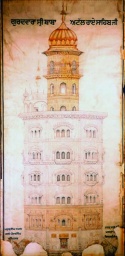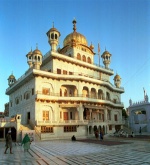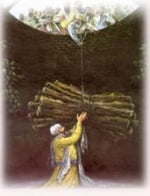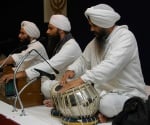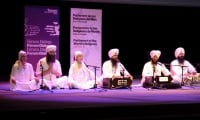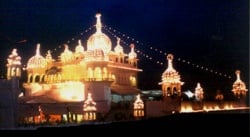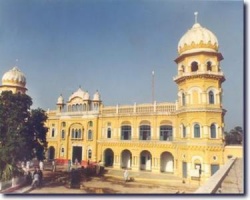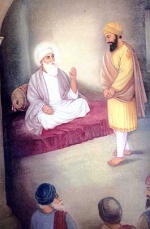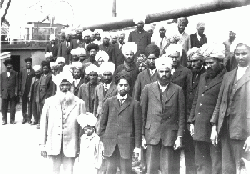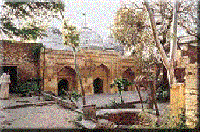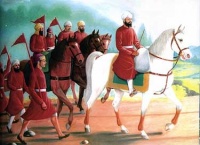SikhiWiki:Today's featured article/February 2009
Today's featured article archive
2007 -
2008 -
2009 -
2010 -
January - February - March - April - May - June - July - August - September - October - November - December
Today is Saturday, April 20, 2024; it is now 15:05 UTC
Featured content:
| << | Today's featured articles for February 2009 | >> | ||||
| Su | Mo | Tu | We | Th | Fr | Sa |
| 1 | 2 | 3 | 4 | 5 | 6 | 7 |
| 8 | 9 | 10 | 11 | 12 | 13 | 14 |
| 15 | 16 | 17 | 18 | 19 | 20 | 21 |
| 22 | 23 | 24 | 25 | 26 | 27 | 28 |
- February 1
Gurdwara Baba Atal Sahib is situated to the south of the Harimandir Sahib or Golden Temple, about 185 metres from Sarai (living accomodation) Guru Ram Das.
The nine-storey octagonal tower, standing 40 metres high, is the tallest building in Amritsar.
Originally a samadhi, or cenotaph, enshrining the remains of Baba Atal Rai, a son of Guru Hargobind, the sixth Guru of the Sikhs.
However, it was transformed, with the passage of time, into a gurdwara, because, in India, "the process of deification is aided by the tendency to develop the tomb raised over a man of eminence into a temple".'
According to popular tradition, Atal Rai, at the age of nine, restored his close friend Mohan, son of a widow, to life after his sudden demise. Guru Hargobind considered his son's act as being against the Sikh tradition and rebuked him for performing a feat involving a miracle and warned him that one's spiritual power should be displayed "in purity of doctrine and holiness of living". It is said that Atal Rai told his father that he would lay down his own life for breaking the law of nature by reviving his friend from the dead. .....More
view – talk – edit – history
- February 2
Ardas is a unique prayer; It's an appeal to Waheguru; a way to address and petition the Almighty; to gain spiritual energy; to connect with God.
It is a very well-known Sikh prayer that was not written in its entirety by the Gurus. The Ardas is an ever changing plea, the contents of which depend on local concerns and personal issues.
The word Ardĝs ( ਅਰਦਾਸ ) is derived from Persian word 'Arazdashat', meaning a request, a supplication, a prayer, a petition or an address to a superior authority.
The power that this single prayer possesses is astonishing. Starting with "Pritham bhagautee simar kai, Gur Nanak laee dhiaa-e" and ending with "Naanak naam charhdee kalaa, tayray bhaanay Sarbat da bhala". The ardas encompasses so many Sikh and Humanistic values. It is more than just a prayer; it is a new concept of therapy for the elevation of the human spirit, mind and body.
The Ardas is usually done standing up with folded hands. The beginning of the Ardas is strictly set by the tenth Sikh Guru, Guru Gobind Singh. When it comes to the conclusion of this prayer, the devotee uses the word Waheguru .....More
view – talk – edit – history
- February 3
Originality and clarity of the Sikh faith was instrumental in promoting it from its inception in about 1499 and the voluntary adoption by the masses with eagerness and whole-heartedness.
Equality, non-discrimination, true justice, and worship of only One God, are basic values that are well-known and gave the world a simple and universal faith.
Today, some 540 years after the birth of the founder of Sikhi, Guru Nanak, it has more than twenty two million followers, and is the fifth largest faith in the world.
Sikhi is respected world over and is known as a religion of peace and unity of mankind. The Sikhs have only fought wars to defend themselves or others but are probably the only section of society that have never fought wars as aggressors.
For the Gurus promoted all human beings as one and the same, and they are all above discrimination. The Gurus showed real love for all of humanity. Muslims were equally dear to them as Hindus, or any others. It is well known that Bhai Mardana a Muslim, spent his whole adult life with Guru Nanak, accompanying Guru with his Rabab as a musician and the Guru's closest companion everywhere that the Guru went. .....More
view – talk – edit – history
- February 4

Lobh is a Gurmukhi and Punjabi word which translates into English as greed, temptation or avarice. Sikhi tells us that it is one of five evils found within most human beings.
The five evils or five thieves or panch doot (five demons) or panj vikar (five sins) as they are referred to in the Sikh Scripture, Guru Granth Sahib, are according to Sikhi, the five major weaknesses of the human personality at variance with its spiritual essence.
The other four evils in the group of five are:
- kam (Lust)
- krodh (Rage or uncontrolled anger)
- moh (Attachment or emotional attachment)
- ahankar (ego)
According to Sikhi, Lobh or greed is the intense desire to possess material items like money, goods, gadgets, properties, cars, jewellery, etc to an extent that is far beyond ones real needs and requirements. A Loby (a person subject to lobh) is the result of a foolish and feeble mind; is happy just thinking about his or her wealth; will continuously be occupied in this desire to possess material items. .....More
view – talk – edit – history
- February 5
Harmandar Sahib, in Punjabi literally means "Temple of God". This is the most important Gurdwara of historical, spiritual, and emotional significance to the Sikhs and is situated in Amritsar, Punjab in north west India.
Guru Amar Das, the third Sikh Guru first conceived of this sacred place; although construction did not begin until Guru Ram Das became the Guru. Maharaja Ranjit Singh had the structure plated with gold in the early 19th century for the first time. During 2003, the gold plating was replaced with new gold.
- "Shining in the morning light, the gilded splendour of its panelling, big dome and small minarets, this temple is a fairy world palace to the devotees of the Sikh faith. Certainly, the first look brings onto the innocent eye the image of a transcendent fact.
The 'loving sight' peering into heaven from the legends of the miraculous cures by the touch of the water in the pool of nectar, in which the shrine stands makes for ecstatic awareness. The vision has been received by millions of pilgrims who have come here for centuries from near and far." (quoted from a devotee) .....More
- February 6
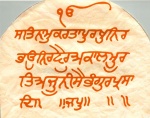
Mool Mantar is the most important composition contained within the Sri Guru Granth Sahib; it is the basis of Sikhism. It’s importance is emphasised by the fact that it is the first composition to appear in the holy Granth and that it appears before the commencement of most of the Raag section within this sacred volume.
Original Gurmukhi Text:
ੴ ਸਤਿ ਨਾਮੁ ਕਰਤਾ ਪੁਰਖੁ ਨਿਰਭਉ ਨਿਰਵੈਰੁ ਅਕਾਲ ਮੂਰਤਿ ਅਜੂਨੀ ਸੈਭੰ ਗੁਰ ਪ੍ਰਸਾਦਿ ॥... ॥ ![]() Play Audio
Play Audio
The Mool Mantar is said to be the first composition uttered by Guru Nanak Dev upon enlightenment at the age of about 30. Being the basis of Sikhism, it encapsulates the entire theology of this faith, and as a result, it is also the most difficult composition to fully understand.
The succeeding bani called the Japji Sahib and the rest of the sacred Granth totalling 1430 pages, are efforts to explain that which is contained within the Mool Mantar. .....More
view – talk – edit – history
- February 7
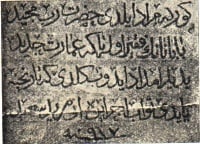
Guru Nanak in Baghdad Swami Ananda Acharya visited the shrine of Guru Nanak in Baghdad and wrote the following:
Upon this simple slab of granite did thou sit, discoursing of fraternal love and holy light, O Guru Nanak, Prince among India’s holy sons.
What song from the source of Seven Waters thou didst sing to charm the soul of Iran!
What place from Himalaya’s lonely caves and forests thou didst carry to the vinegroves and rose-gardens of Baghdad?
What light from Badrinath’s snowy peak thou didst bear to illumine the heart of Bahlol, thy saintly Persian disciple?
Eighty-four nights Bahlol hearkened to thy words of Life and the Path and Spring Eternal, while the moon waxed and waned in the pomegranate grove beside the grassy desert of the dead.
And after thou hast left him to return to thy beloved Bharat’s land, the fakir, it is said, would speak to none nor listen to the voice of man or angel; ....Continued
view – talk – edit – history
- February 8
Akal Takhat (Punjabi: ਅਕਾਲ ਤਖ਼ਤ) means the Throne of the Immortal and is historically the highest political institution of the Sikhs.
"Akal" means "The Timeless One" - another term for God. "Takhat" means "throne" in Persian. This is one of a total of five takhat of the Sikhs.
The Akal Takhat is an impressive building that sits directly in front of the causeway leading to the Golden Temple in Amritsar.
This institution was founded by Guru Hargobind on July 2, 1606 and was established as the place from which the spiritual and temporal (Miri Piri) concerns of the Sikh community could be acted upon.
It stood as a symbol of political bulwark against the Mughal Emperors in the 17th and 18th century. Various attacks on the Akal Takhat and Harmandar Sahib have taken place in the past by Ahmed Shah Abdali and Massa Rangar in the 18 century.
On June 4, 1984, the Indian Army damaged the outer façade of the Akal Takhat while attempting to flush out Sikh militants in a controversial military operation known as Operation Bluestar. .....More
view – talk – edit – history
- February 9

In his lifetime Guru Nanak, the founder of the Sikh religion travelled to distant places and one such place was Tibet.
The Guru is well respected by Tibetan Buddhists who consider him a saint; the Dalai Lama, spiritual leader of Buddhists in Tibet, has confirmed it in his discussions with some Sikh leaders that Tibetans revere Guru Nanak as a Buddhist saint under the name of Guru Gompka Maharaj.
According to the local legends of North Sikkim, some people approached the respected Guru with an appeal for help. The lake had remained frozen during most of the year and rendered it incapable as a source of water.
Guru Nanak Dev ji is said to have touched the lake with his foot, and it has never frozen since. Guru Nanak's footprints, a robe and a water-carrying utensil are preserved in a nearby place called Lachen Gompha. Here the locals refer to the Guru as Rimpoche Nanak Guru who on his way to Tibet had rested there. .....More
view – talk – edit – history
- February 10
Bhai Manjh In the time of Guru Arjan Dev ji, there was a powerful and rich Jatt by the name of Teeratha. Teeratha was a follower of the Muslim sect of Sakhee Sarvar.
He was the local leader of this sect and had hundreds of followers who all respected him. Teeratha would regularly lead the members of this sect on a pilgrimage to the main Sakhee Sarvar shrine now in Pakistan
Once when passing through Amritsar, Teeratha decided to visit Guru Arjan. He had heard that there was a great Guru who had a large following and this Guru was spiritually enlightened.
He was curious to know who this Guru was and what he would say. He decided to stop off and see the Darbar of Guru Arjan. When he saw the Darbar, he saw that people of many different backgrounds, and castes were all sitting together and living in harmony. He also heard the kirtan in the darbar and the kirtan left a permanent mark on him. He heard of the great gift of naam and the thirst to have this gift rose within him. He was the leader of hundreds of "Sakhee Sarvar" followers but he could no longer follow that path. He realised that Sikhi was the path he must follow. .....More
view – talk – edit – history
- February 11
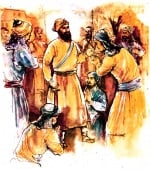
Sahibzada Ajit Singh (11 February 1687 - 7 December 1705), the eldest of four sons of Guru Gobind Singh, was born to Mata Jito ji (also known as Mata Sundari ji) at Paonta sahib on 11 February 1687. The following year, Guru Gobind Singh returned with the family to Anandpur sahib where Ajit Singh was brought up in the approved Sikh style.
He was taught the religious texts, philosophy and history, and had training in the martial arts such as riding, swordsmanship, gatka and archery. He grew up to be a handsome young man, strong, intelligent and a natural leader of people. Soon after the creation of the Khalsa on 30 March 1699, he had his first test of skill. A group of Sikhs (sangat) coming from Pothohar, northwest Punjab, was attacked and looted on the way by the Ranghars of Nuh, a short distance from Anandpur across the River Sutlej.
Guru Gobind Singh sent Sahibzada Ajit Singh, barely 12 years of age then, to that village to intervene, defend the sangat and deal with the intruders. Ajit Singh at the head of 100 Sikhs reached there on 23 May 1699, punished the Ranghars and recovered the looted property. .....More
view – talk – edit – history
- February 12
The new month of Phagun starts on the February 12 each year. This is the twelfth and final month in the Nanakshahi calendar, which governs activity within Sikhism.
In Punjab where Guru Nanak resided, this month marks the end of winter and the beginning of spring. This month coincides with February - March of the Western/Georgian/Julian Calendar and is 30 days long except in leap years when its 31 days long.
This is what the Guru Granth Sahib says about this month:
| In the month of Phalgun, bliss comes to those, unto whom the Lord, the Friend, has been revealed. The Saints, the Lord’s helpers, in their mercy, have united me with Him. My bed is beautiful, and I have all the comforts. I feel no sadness at all. My desires have been fulfilled - by great good fortune, I have obtained the Sovereign Lord as my Husband. Join with me, my sisters, and sing the songs of rejoicing and the Hymns of the Lord of the Universe. There is no other like the Lord - there is no equal to Him. He embellishes this world and the world hereafter, and He gives us our permanent home there. He rescues us from the world-ocean; never again do we have to run the cycle of reincarnation. I have only one tongue, but Your Glorious Virtues are beyond counting. Nanak is saved, falling at Your Feet. In Phalgun, praise Him continually; He has not even an iota of greed. ((13)) |
| SGGS page 136 |
- February 13
- "Consumed by greed the world is burning and dying; while burning, it cries in agony.
If it meets with the soothing Lord, it will not burn any more.
O Nanak, without Naam and without contemplating the Word, one cannot become fearless." (SGGS p588)
We find today the whole world burning in the fire of greed and hatred. Everyday we read the reports of bloodshed and the loss of innocent lives.
There are some people in the world committing suicide to kill their opponents. So the cycle of revenge escalating evermore on a daily basis.
The circle of casualty is increasing daily and it is coming in our direction. One day, it will hit us! What then?
Knowing this, still most people are too involved in their own everyday little problems and daily struggles to even take a few minutes to stop and think. You probably are thinking right now to stop reading this article. You are thinking I have many other things to do. I need to do X then Y then Z; I will read this later when I have finished X, Y and Z. Right!
Well, that is how the world has got into this diabolical state. .....More
view – talk – edit – history
- February 14

Japji sahib is the name given to the first bani (holy composition) to appear at the very beginning of the Sri Guru Granth Sahib from Page 1 to Page 8 of the sacred Granth (book) of the Sikhs.
The composition consists of the Mool Mantar (root mantar), a set of 38 Pauris (hymns) and a final Salok. Japji sahib is regarded as the most important bani or 'set of verses' by the Sikhs and is recited every morning by all practising faithful of this religion. The word ‘Jap’ means to ‘recite’ or ‘to ‘chant’. ‘ji’ is a word that is used to show respect as is the word ‘sahib’.
This Gurbani (words of the Guru) is said to be the condensation of the whole of the Sri Guru Granth Sahib and whoever recites this Bani with love, dedication and humility will have the complete blessing of Guru Nanak Dev. .....More
view – talk – edit – history
- February 15
- "In this dark era of Kalyug, the singing of Kirtan is king,
the Gurmukhs sing it with their minds focused.
you save yourself and all your clan and go to the Lord's Court with honour. (6)" (SGGS p1075)
In this Shabad on page 1075 of the Sikh holy Granth, the fifth Sikh master, Guru Arjan Dev tells how important it is to sing Kirtan in this age of Kaljug. Kirtan is the singing of the Lord's praises with the accompaniment of musical instruments.
The Sikhs regard the Guru Granth Sahib as their perpetual spiritual guide. At the same time, it is a holy Scripture for all mankind that embodies the revealed truth applicable to all the human race. The holy Granth enshrines the wisdom of many spiritual masters of the East and is the most recent endeavour to allow us to experience the Divine.
Although Kirtan refers to any singing of the Lord's praise, for the Sikhs, it is the singing of hymns (Shabads) from their holy Scriptures. .....More
view – talk – edit – history
- February 16
Sikhism is one religion, which is founded on the principles of global Interfaith communities and mutual Inter-community respect and harmony. The founders of Sikhism have, since 1469, defined and preached the principles of interfaith respect, dialogue and harmony.
A Sikh by definition must respect and accept all other world religions. Guru Nanak, the founding Guru of the Sikh faith said, "Your [God's] Divine Light is contained in all; everyone belongs to You." (SGGS page 414) So in this religion the holiness of all humans is recognised and respected, irrelevant of the person's religion.
Further, the Sikh must protect, guard and allow the free-practise of the customs and rituals of other religions. The SGGS says on page 142: One who recognizes that all spiritual paths lead to the One shall be emancipated.
The following are remarks made by distinguished personalities about the Sri Guru Granth Sahib and its interfaith message:
Arnold Toynbee: The Adi Granth is remarkable for several reasons. Of all known religious scriptures this book is the most highly venerated.
Pearl S. Buck: They (the Sikh Scriptures) speak to persons of any religion or of none. They speak for the human heart and the searching mind.
Dr. S. Radhaknshnan: The barriers of seas and mountains will give way before the call of eternal truth which is set forth with freshness of feelings and fervour of devotion in the Adi Granth. .....More
view – talk – edit – history
- February 17
Darshan is a Punjabi word which means "viewing" or "meeting". I woke up earlier than usual on darshan day.
The time must have been a little after midnight. Something seemed different that day. With difficulty I lifted my head and peeped out of the small window of my hut.
Although I could not see anything due to the pitch darkness of the night, I sensed some activity in the trees.
I closed my eyes and listened carefully. To my surprise I sensed the trees were in the same jovial mood as they were when spring was approaching. Winter had just started; it would be months before even the slightest hint of spring.
I lay down my head back on the pillow and realised that I too was in a jovial mood - my heart too hinted some hope and excitement. That was quite a change from the past few years of my miserable and painful existence. .....More
view – talk – edit – history
- February 18
Giani Sant Singh Maskeen (1934-18 February 2005) was born in 1934 at a place called Lak Marwat in District Bannu in present Pakistan.
Giani ji was the only son of his parents and had lived at Alwar in Rajasthan for the last 57 years of his life.
He was honoured by the Sikh community with the rare title of “Panth Rattan” for his services to mankind through the message of Gurbani. Sadly “Panth Rattan” Giani Sant Singh Maskeen passed away on 18th February 2005 at approximately 8.00 AM I.S.T. due to a massive heart attack while attending a marriage function in Etawah in Uttar Pradesh, India.
It is beyond doubt that Giani Sant Singh Maskeen was the most venerated and best known religious scholar among the Sikhs. This was due to the fact that he had in-depth and a broad knowledge of Gurmat and Gurbani; deep knowledge and understanding of comparative religions; and was armed with an excellent art of delivery of this vast knowledge database. .....More
view – talk – edit – history
- February 19
A close friend of mine, Professor Jap Singh, a professor at a Ludhiana university, narrated this episode to me about two decades ago. I repeat below what my friend described to me:
Professor: "You know, I contribute regularly for gurdwara (Sikh temple) functions. One year, special Gurpurb celebrations were arranged by the campus residents of the Panjab Agriculture University, Ludhiana.
The organisers as usual visited me for my contribution. I usually gave 25 rupees every time they came for collection. They told me, “This will be a special function, we want a bigger contributions from you this time, Professor. Mr. ABC (a clerk) paid 20 rupees.”
I took this as a signal for me to double my contribution. However, keeping my recent promotion and position at the University in mind, I contributed one hundred rupees. The members were very pleased since they expected only 50 rupees.
When the organisers left, my ego overtook me, “Look! I am a great Sikh. This contribution will draw God’s attention and He will give me special rewards for this donation.”
On the day of the special Gurpurb, I deeply regret and am embarrassed to tell you (I know you won’t reveal my name to others) what went through my mind. When I went through the aisle to pay my respect to the Guru Granth Sahib, I could not help looking at the Sangat already sitting there.
Drenched in my ego, I said to myself, “This person would have paid only five rupees; this teacher might have given ten rupees; .....More
view – talk – edit – history
- February 20
12 O'clock Joke: For all of you who thought of the '12 o Clock joke' as a slam against Sardars, just read the following story.
I was standing at railway Station (New Delhi) when my attention went towards a Sikh youth standing near me wearing a black turban having a long beard and wearing a kirpan over his shirt looking similar to what some people might think of as a terrorist.
After a while, one local train arrived, which was totally packed. The Sikh youth tried to board the train but failed to do so. Just then a voice was heard from the back coach, 'Sardarji Barah Baj gaye' (Sir, it's 12 o'clock!)
The Sikh youth turned to look at the person who had said the words, who to me seemed a young mischievous type of person, but instead of showing any anger the young Sikh made a knowing smile towards him.
The smile he made was so enigmatic that it seemed as if some type of truth lay behind it. Not able to resist my temptation to ask the young man a question, I walked towards him and asked why he had smiled at the person who had teased him. The Sikh youth replied, "He was not teasing me but was asking for my Help". .....More
view – talk – edit – history
- February 21
On February 21, the Sikh sangat worldwide will remember the sacrifices made during Saka Nankana Sahib. This event forms a very important part of Sikh history.
In political significance, it comes next only to Jallianwala Bagh massacre of April 1919. The saka (demonstration or agitation) constitutes the core of the Gurdwara Reform Movement started by the Sikhs in early twentieth century. The interesting part of this saka is the unprecedented discipline, self-control and exemplary patience displayed by the peaceful Sikh protesters even in the face of extreme barbarism.
Even the national leaders like Mahatama Gandhi had to acknowledge in no ambiguous terms the glory and the prestige which the peaceful and passive resistance of the Sikhs had brought to the India's struggle for freedom.
In October 1920 A.D., a large meeting was held at Dharowal, District Sheikhupura for the reform of Gurdwara Nankana Sahib. At this meeting, the leaders of the event revealed to the large gathering of Sangat, that great misdeeds were being committed inside the Gurdwara by the Mahant who was managing the holy shrine.
Gurdwara Nankana Sahib was highly revered as it was the birth place of Guru Nanak; a city named Nankana Sahib grew up around the Gurdwara which is now in Pakistan. At meeting, it was unanimously resolved that the Mahant be asked to mend his ways. .....More
view – talk – edit – history
- February 22
Bhai Lehna decided to stay with Guru Nanak at Kartarpur. However, Bhai Lehna’s companions left without him and continued their journey for Jawalamukhi to worship the goddess Durga.
After staying for a few days at Kartarpur, Bhai sahib said to himself, ‘Let me go to my village and tell my family and friends about my plans to stay with Guru Nanak. Then I shall come back and stay with the Guru for a longer period and no one will worry about my whereabouts.’'
Bhai sahib then went back to his village called Khadur Sahib in district Amritsar. He stayed at his village for a few days only but soon, he was ready to return to Kartarpur as he wanted to be with the Guru. He had enjoyed being in the company of the Guru and the Sangat; he wanted to learn from the Guru and to serve him and the community; this was the custom in those days. He wanted to become a disciple of Guru Nanak and learn true wisdom about life from him.
Before starting his journey back, he said to himself, ‘I must take something with me for the Guru. He runs a free kitchen. Scores of people take their meals from there. They do not have to pay anything for the meals. I should take something for the Langar or "free kitchen for all". But what should I take? Yes, let it be as heavy a load of salt as I can carry on my head.’ ....Continued.
view – talk – edit – history
- February 23
The Komagata Maru was a Japanese steam liner, that was chartered by an affluent businessman, Gurdit Singh, to bring Indian immigrants to Canada in 1914.
It began its journey from Hong Kong, sailed to Shanghai, China, then to Yokohama, Japan, and then on to Vancouver, British Columbia Canada where it arrived in Burrard Inlet, near Vancouver, on May 23. This journey took place in 1914, carrying 376 passengers from Punjab, India.
During the period before 1920's the whole of North America has a policy of discrimination against coloured races which was thinly disguised to appear as something else. The dominate white governments of USA and Canada were determined not to allow the flow of Asians, whether so called 'yellow', 'brown' or 'black' immigrants. In the year 1900 the census reported 2050 people from India on the North American continent.
The majority of these Indians were Punjabis who had settled in Canada in the hope of finding work so that they could improve their economic situation from what it had been in the Punjab. .....More
view – talk – edit – history
- February 24
The Sikh organisation, UNITED SIKHS launched the "Feed the Hungry" campaign back in February 2009. This campaign brought winter solace to many homeless in Toronto, Canada.
Like other Sikh bodies, this step follows the tradition of Langar (serving of free food) which was first introduced by the founder of Sikhism, Guru Nanak during the late 1400's.
"Under the "Feed the Hungry" campaign, UNITED SIKHS will work with locally based Gurdwaras (Sikh place of worship), to feed and clothe the needy from all communities around the world. To date 10 Gurdwaras in Ontario have agreed to participate in this campaign," said Charankamal Singh, Sikh Aid Director of UNITED SIKHS (Canada). This is just the beginning. It is hoped that many such hundreds of projects will be initiated all over the world with the many thousands of Gurdwaras around the world taking part.
On the crisp cold morning of 20th February, 2009 the Parkdale Recreation Centre of downtown Toronto was filled with sewadars (volunteers) wearing a dastaar (a Sikh turban), who were serving hot-meals, beverages and distributing warm clothes. .....More
view – talk – edit – history
- February 25
The Gurbani of the Guru Granth Sahib has a lot to say about the Lord of the Universe and His (or Her) creation.
God in Sikhism is a term used to denote any object of worship or evocation used to signify the belief of most modern religions in the existence of a "Supreme Being" or "Supreme Spirit" who is the source and support of the spatio-temporal material world.
Theologians remember Him by the name of God. The fundamental belief of Sikhism, too, is that God exists, not merely as an idea or concept, but as a "Real Being", indescribable yet not unknowable. The Sikh Masters, however, never theorized about proofs of the existence of God.
For them the Creator of all that exists is too real and obvious to need any logical proof. Guru Arjan, Nanak V, says, "God is beyond colour and form, yet His presence is clearly visible" (GG, 74), and again, "Nanak's Lord transcends the world as well as the scriptures of the east and the west, and yet he is clearly manifest" (GG, 397). .....More
view – talk – edit – history
- February 26
Guru Nanak (1469-1539) promulgated a unique and universal philosophy of humanism in the Indian sub-continent as the renaissance was taking place in Europe (14th to 16th centuries) and scientists were challenging illogical religious concepts and beliefs.
The Guru carried his message far and wide to South Asia and the Middle East. He held discussions with religious leaders: Hindus—(Brahmans, Sidhs and Jogis), Muslims—(Sufis, mullahs and Qazis), Jains and Buddhists in India, the Middle East, Tibet and Ceylon (Sri Lanka), etc
During his travels (odysseys, Udasis) Guru Nanak challenged the ancient mythology, wrong religious concepts and rituals with which the peoples of South Asia and Middle East were shackled for centuries. People were unable to express their freewill in any aspect of their lives because their lives were controlled by their religious and political authorities.
Guru Nanak launched his movement to liberate the masses form ignorance and religious and political tyranny. His philosophy, termed as ”Nanakian Philosophy‘, is embodied in his Bani (Word), which has been incorporated in the Aad Guru Granth Sahib (AGGS). .....More
view – talk – edit – history
- February 27
In December 1634, Guru Hargobind Sahib fought a fierce battle against Mughal forces near the river Beas. Although heavily outnumbered, the Guru was victorious.
Guru Sahib decided to stay at this location for a while, and soon a settlement grew up at the site. The settlement expanded into a town which became known as Sri Hargobindpur. As the ongoing conflict with the Mughals was intensifying the town's defences were fortified.
In fact, these fortifications were so solid that the original city walls and many buildings within are still visible today throughout Sri Hargobindpur in Gurdaspur district, Punjab.
Residents of all faiths flocked to the Guru and perceived themselves as heirs to the sixth Guru’s desire to found a secure and secular home on the banks of the Beas. The Sikhs built themselves a Gurdwara but the few local Muslims did not have the capacity to build themselves a place of worship.
So they came to the Guru and asked him for help. The All-Knowing Guru was equally comfortable with Muslim faqirs and Hindu sadhus and saw all people with one benevolent gaze. The Guru ordered his Sikhs to start construction of a mosque or "Masjid". The Masjid was duly completed and turned over to the Muslims. .....More
view – talk – edit – history
- February 28
Sri Lehna was a pious man who lived in the village of Khadur near the town of Tarn Taran, in present-day district of Amritsar.
He was a good and honest man, whose skills and hard work as a shopkeeper had made him a very wealthy man. A Hindu he was a worshipper of the goddess Durga as were many other people of his village.
Every year he led a large group of his villagers on a pilgrimage to a famous temple of Durga in the foothills of the Himalayas called Jawalamukhi. He wore traditional bands of bells on his ankles and wrists dancing along the way singing bajans (songs) about the stories of the fabled tales of the battles of the goddess with mystical demons. Arriving at the temple he and many other bands of pilgrims would dance before the goddess with their bells tinkling when they danced about.
He had done this his whole life until one day as an old man he chanced to meet with another man in his village who was a Sikh, a follower of Guru Nanak. This man's name was Bhai Jodha. He was not a worshipper of Durga, as no Sikh worships any of the Hindu gods or goddesses. All Sikhs are worshippers of one God, commonly called "Waheguru". Bhai Jodha did not visit Durga’s temple. .....More
view – talk – edit – history
